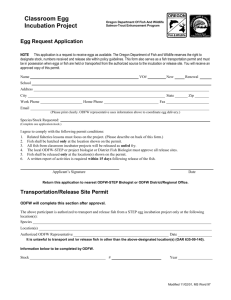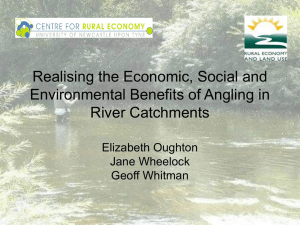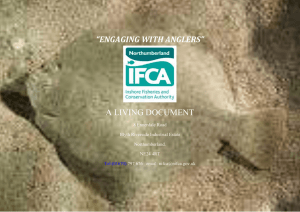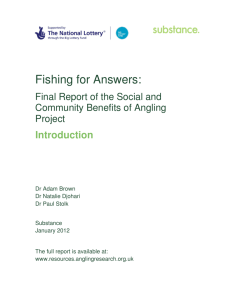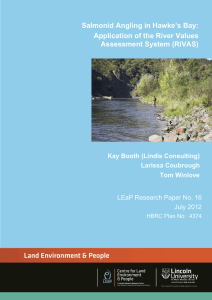New ODFW review criteria for public proposals: Is the proposal
advertisement
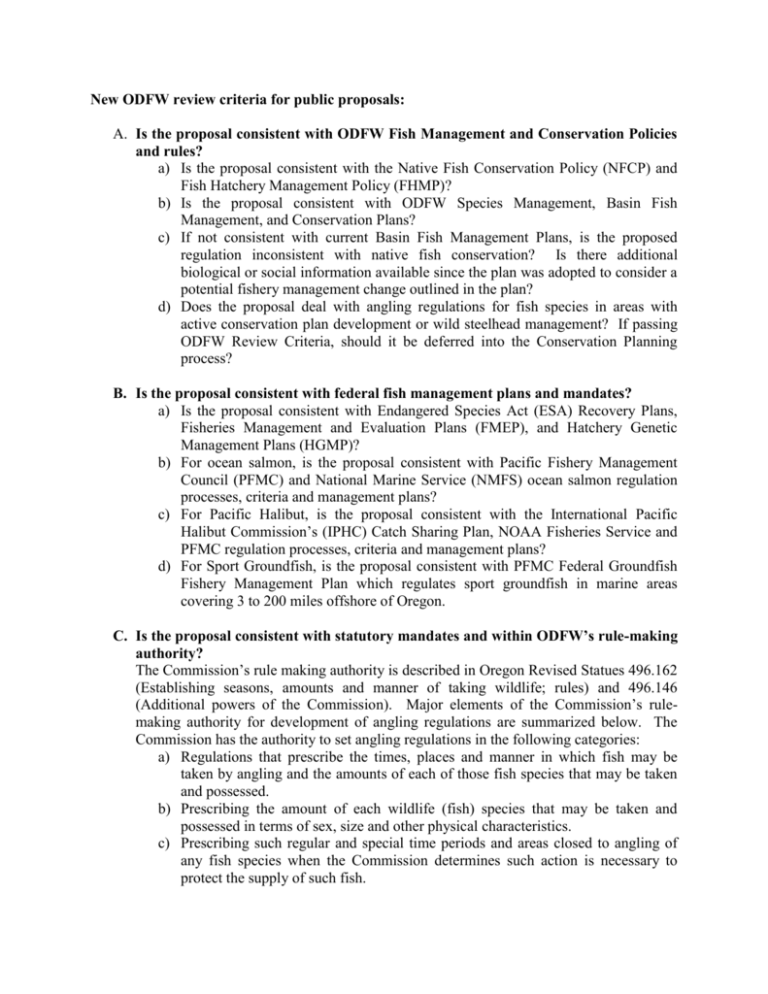
New ODFW review criteria for public proposals: A. Is the proposal consistent with ODFW Fish Management and Conservation Policies and rules? a) Is the proposal consistent with the Native Fish Conservation Policy (NFCP) and Fish Hatchery Management Policy (FHMP)? b) Is the proposal consistent with ODFW Species Management, Basin Fish Management, and Conservation Plans? c) If not consistent with current Basin Fish Management Plans, is the proposed regulation inconsistent with native fish conservation? Is there additional biological or social information available since the plan was adopted to consider a potential fishery management change outlined in the plan? d) Does the proposal deal with angling regulations for fish species in areas with active conservation plan development or wild steelhead management? If passing ODFW Review Criteria, should it be deferred into the Conservation Planning process? B. Is the proposal consistent with federal fish management plans and mandates? a) Is the proposal consistent with Endangered Species Act (ESA) Recovery Plans, Fisheries Management and Evaluation Plans (FMEP), and Hatchery Genetic Management Plans (HGMP)? b) For ocean salmon, is the proposal consistent with Pacific Fishery Management Council (PFMC) and National Marine Service (NMFS) ocean salmon regulation processes, criteria and management plans? c) For Pacific Halibut, is the proposal consistent with the International Pacific Halibut Commission’s (IPHC) Catch Sharing Plan, NOAA Fisheries Service and PFMC regulation processes, criteria and management plans? d) For Sport Groundfish, is the proposal consistent with PFMC Federal Groundfish Fishery Management Plan which regulates sport groundfish in marine areas covering 3 to 200 miles offshore of Oregon. C. Is the proposal consistent with statutory mandates and within ODFW’s rule-making authority? The Commission’s rule making authority is described in Oregon Revised Statues 496.162 (Establishing seasons, amounts and manner of taking wildlife; rules) and 496.146 (Additional powers of the Commission). Major elements of the Commission’s rulemaking authority for development of angling regulations are summarized below. The Commission has the authority to set angling regulations in the following categories: a) Regulations that prescribe the times, places and manner in which fish may be taken by angling and the amounts of each of those fish species that may be taken and possessed. b) Prescribing the amount of each wildlife (fish) species that may be taken and possessed in terms of sex, size and other physical characteristics. c) Prescribing such regular and special time periods and areas closed to angling of any fish species when the Commission determines such action is necessary to protect the supply of such fish. d) Require the holder of any license, tag or permit issued pursuant to the wildlife laws (fishing regulations) to keep records and make reports concerning the time, manner and place of taking wildlife (includes fish), the quantities taken and such other information as the commission determines necessary for proper enforcement of the wildlife laws or to obtain information for use in wildlife management. e) Establish special angling areas or seasons in which only persons less than 18 years of age or over 65 years of age are permitted to angle. f) Establish special fishing seasons and bag limits applicable only to persons with disabilities. g) Regulations which prescribe such other restrictions or procedures regarding the angling or possessing of fish species as the Commission determines will carry out the provisions of wildlife laws. The Commission does not have rule-making authority for: a) Changes in any fees associated with licenses or tags, revise tag or license structures, or add any new tags or licenses. b) Special regulations for licensed angling guides and/or their clients. c) Special regulations on the use of motor boats or boat motors on state waters. Note: This list includes some of the more common rule changes proposed in past public processes and is not intended to represent all areas outside of the Commission’s rulemaking authority just some common examples). D. Is the proposal based on an establish need? a) Is protection needed? Is the rule necessary to balance harvest and conservation? b) Is the fishery resource being appropriately allocated to the various user groups? c) Is the proposed rule needed to meet an identified fishery or fish management objective (Basin Plan, 25-Year Plan, etc)? E. Is the proposal consistent with biologically sound principles and biologically feasible? a) Is the proposed regulation objective biologically feasible? b) Is the proposed regulation objective based on sound science? c) Can the biological response necessary to meet the intent of the regulations be reasonably expected to occur? d) Is there an acceptable level of biological risk? F. Is the need? a) b) c) d) proposal supported by affected citizens and addresses an established social Does the proposal make social sense? What is the level of public support or opposition? What groups support and what groups oppose? Social proposals with no clear or established public support or have potential to cause social problems or conflict will be rejected. e) How is the level of public support measured in the proposal? i. Public support can also be assessed using existing social surveys ODFW has conducted, or surveys conducted by other entities which could be used to assess public opinion or support. Caution should be used when considering surveys not conducted by professionals because of inherent bias. Survey information included in public proposals should be reviewed and evaluate for accuracy and relevancy. f) Social regulation issues may also be evaluated based on Angling Zones or a statewide basis as well as specific water body basis. G. Easily understood with clearly defined limits or boundaries? a) Is the proposed rule language clear and concise? b) Does the proposal use terminology that is consistent with existing regulations? H. Is the proposal enforceable? a) Has the proposal been tried in the past and found to be un-enforceable? b) Can OSP adequately enforce the proposed rule? c) Is the proposed rule supported by affected anglers? Regulation Context d) Does the proposal result in more complex or simplified regulations? e) What is the past regulation history, has the proposal been considered before? If so, have circumstances changed that allow this proposal to be considered at this time? f) How long has the current angling regulation been in place? g) What are the potential economic impacts of the proposal?



